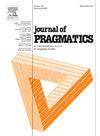与晚期痴呆症患者互动的沟通意图和阈限信号
IF 1.8
1区 文学
0 LANGUAGE & LINGUISTICS
引用次数: 0
摘要
本研究探讨了护理人员在将晚期痴呆症患者的身体行为解释为相互作用信号时所面临的挑战。晚期痴呆症患者经常表现出模棱两可的非语言行为,被称为阈限信号,不能立即识别为交流。根据Goffman对“给予”和“释放”信息的区分以及Grice的交流意图理论,我们分析了照顾者可能注意到或不注意到这些信号并做出反应的互动序列。研究结果强调了具体行为的潜力,如非语言发声和手势,作为交流信号。三个实证例子表明,情境线索如何帮助护理人员认识到这些行为是有意义的贡献,将痴呆症患者定位为互动中的伙伴,并为他们的代理和声音提供表达的机会。因此,该研究对理解阈限信号具有理论意义,并对改善痴呆症护理中的沟通具有实际意义。本文章由计算机程序翻译,如有差异,请以英文原文为准。
Communicative intentions and liminal signs in interaction with people living with late-stage dementia
This study examines the challenges caregivers face in interpreting the bodily behaviors of individuals with late-stage dementia as interactional signals. People with late-stage dementia often exhibit ambiguous, non-verbal conduct, referred to as liminal signs, which are not immediately recognized as communicative. Drawing on Goffman's distinction between “giving” and “giving off” information and Grice's theory of communicative intentions, we analyze interaction sequences where caregivers may or may not notice and respond to these signs. The findings highlight the potential for embodied conduct, such as non-verbal vocalizations and ge2stures, to serve as communicative signals. Three empirical examples show how contextual cues can help caregivers recognize these conduct as meaningful contributions, positioning the person with dementia as a partner in interaction and providing an opportunity for their agency to be expressed and their voice to be heard. The study therefore has theoretical implications for understanding liminal signs and practical implications for improving communication in dementia care.
求助全文
通过发布文献求助,成功后即可免费获取论文全文。
去求助
来源期刊

Journal of Pragmatics
Multiple-
CiteScore
3.90
自引率
18.80%
发文量
219
期刊介绍:
Since 1977, the Journal of Pragmatics has provided a forum for bringing together a wide range of research in pragmatics, including cognitive pragmatics, corpus pragmatics, experimental pragmatics, historical pragmatics, interpersonal pragmatics, multimodal pragmatics, sociopragmatics, theoretical pragmatics and related fields. Our aim is to publish innovative pragmatic scholarship from all perspectives, which contributes to theories of how speakers produce and interpret language in different contexts drawing on attested data from a wide range of languages/cultures in different parts of the world. The Journal of Pragmatics also encourages work that uses attested language data to explore the relationship between pragmatics and neighbouring research areas such as semantics, discourse analysis, conversation analysis and ethnomethodology, interactional linguistics, sociolinguistics, linguistic anthropology, media studies, psychology, sociology, and the philosophy of language. Alongside full-length articles, discussion notes and book reviews, the journal welcomes proposals for high quality special issues in all areas of pragmatics which make a significant contribution to a topical or developing area at the cutting-edge of research.
 求助内容:
求助内容: 应助结果提醒方式:
应助结果提醒方式:


